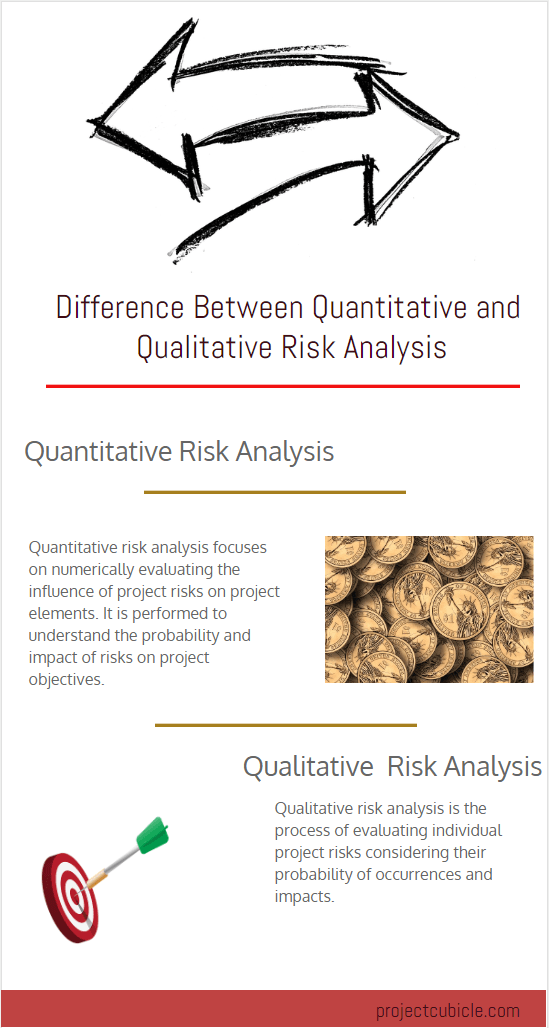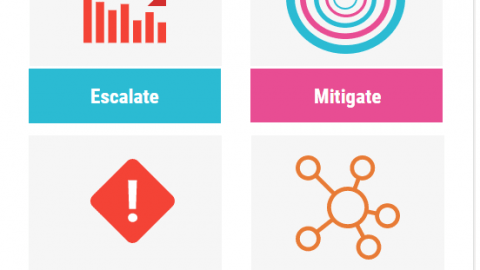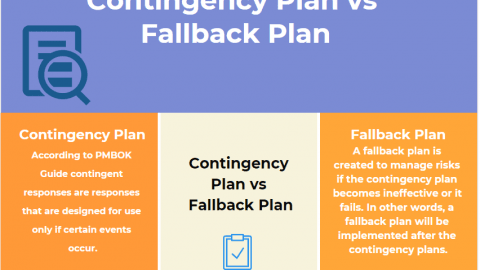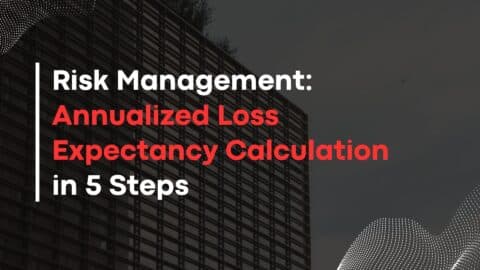Difference Between Quantitative and Qualitative Risk Analysis
If you are preparing for your CAPM or PMP Certification Exam, you should know the key points of qualitative risk analysis and quantitative risk analysis. Both processes are included in the “Project Risk Management” knowledge area. Although both concepts sound quite similar and use numbers for risk assessment, they refer to two different concepts. A lot of PMP aspirants often get confused about what roles they play to support your risk analysis process. In this article, we will explain the difference between quantitative and qualitative risk analysis and show how they vary.
Table of Contents
7 Processes of Risk Management Knowledge Area
According to the PMI PMBOK Guide, the risk management knowledge area has seven processes.
- Plan Risk Management
- Identify Risks
- Perform Qualitative Risk Analysis
- Perform Quantitative Risk Analysis
- Plan Risk Responses
- Implement Risk Responses
- Monitor Risks
During the identify risks process, all project risks are identified and documented in a risk register. After that, perform risk analysis process comes in which you conduct a qualitative and quantitative risk analysis. Note that quantitative risk analysis is optional. It can be performed if you need a more accurate and objective risk analysis for a given risk. Then you will establish risk response strategies to deal with both positive and negative risks. Finally, the control risks process comes in which you monitor and control project risks.
Simply put, qualitative risk analysis focuses on evaluating each project risk by using the probability of occurring and their impacts on the project elements. Multiplying the probability and impact of a project risk gives a risk score which is used to prioritize the risks.
On the other hand, quantitative risk analysis provides numerical estimates of the influence of risks on the project objectives. Numerical estimates include duration and cost estimates to support decision-making. Typically, project risks are prioritized during the perform qualitative risk analysis process and analyzed and updated in detail in the quantitative risk analysis process depending on the numerical analysis.
So, why don’t we perform Quantitative Risk Analysis all time and why is it optional? The answer is simple, as a project manager, you don’t have enough time to deal with all project risks at any level. On the other hand, if you perform only a qualitative risk analysis, you conducted the overall risk analysis process partially.
How Quantitative and Qualitative Risk Analysis Differ
The most noticeable difference between qualitative and quantitative risk analysis is that the first one deals with individual project risks, where the second one considers the project risks as a whole. The overall project risk refers to the combined effect of all risks rather than individual effects on cost or schedule.
Qualitative risk analysis is a subjective tool that uses numbers for the risk score. For example, if the probability of a risk is 3 and its impact is 4, then the risk score will be 12 (3×4). The risk score is calculated by multiplying the possibility and impact. On the other hand, quantitative risk analysis calculates the impact of a risk on project objectives as a numerical value such as $50,000 or ten days.
Using Risk Register
To provide a better understanding, let’s take a look at the below risk register that is created during identify risks process. This risk register includes both positive and negative risks.
| Risk ID | Risk Description | Probability | Impact | Risk Score |
| 01 | Insufficient Amount of Coders | 2 | 4 | 8 |
| 02 | Delayed Delivery | 2 | 2 | 4 |
| 03 | Need for Advanced Testing to Eliminate Defects | 3 | 5 | 15 |
| 04 | Reuse of Existing Testing System | 4 | 5 | 20 |
As shown in the table above, in qualitative risk analysis, probability and impact values are determined for each risk and the risk score is calculated by multiplying them. Depending on the risk scores, you prioritize each risk and establish risk response strategies for both positive and negative risks if the score exceeds risk tolerance limits.
In the below table, we will perform quantitative risk analysis by assigning monetary values for the impact of each risk and percentages for their probability of occurrence.
| Risk ID | Risk Description | Probability | Impact | Expected Monetary Value (EMV) |
| 01 | Insufficient Amount of Coders | 40% | $30.000 | $12.000 |
| 02 | Delayed Delivery | 40% | $40.000 | $16.000 |
| 03 | Need of Advanced Testing to Eliminate Defects | 60% | $25.000 | $15.000 |
| 04 | Reuse of Existing Testing System | 80% | -$45.000 | -$36.000 |
| TOTAL Expected Monetary Value (EMV) | $7.000 | |||
Note that “Reuse of Existing Testing System” is a positive risk. Therefore it decreases the Expected Monetary Value (EMV).
What is the Difference Between Quantitative and Qualitative Risk Analysis?
The below table illustrates the difference between quantitative and qualitative risk analysis.
| Qualitative Risk Analysis | Quantitative Risk Analysis |
| Risk level | Project level |
| Easy to perform | Time-consuming |
| Does not require a software tool | Software tools facilitate the process |
| Subjective evaluation of probability and impact | Objective/numeric evaluation of probability and impact |
| Should be done first | Should be done after performing qualitative analysis |
| Analyzes the effects of individual project risks | Analyzes the combined effects of risks as a whole to specify an overall project risk. |
| Useful in all-size projects | Useful in especially in large and sophisticated projects |
| Risk scale and scores are qualitative | Risk scale and scores are quantitative -often specified in monetary and duration terms |
| Not Applicable | Determines the amount of Contingency Reserve |
| Provides quick information | Provides detailed information |
Conclusion
Obviously, risk analysis is an important process in project risk management. Without proper risk analysis, project managers can not prioritize their project risks and establish response strategies to deal with them. In this article, we explained the difference between quantitative and qualitative risk analysis and showed how they vary. If you are preparing for your CAPM or PMP Certification Exam, you should know their differences well because you may encounter one or more than one question during the exam. If you want to add or share anything regarding the difference between quantitative and qualitative risk analysis, you can do so through the comments section below.
See Also
Further Reading

Francois Simosa is the head of training for the Gragados Training Associates, which provides special project management and risk management training programs.











I would always mix these two but now that I have read the article. I surely know the difference between them.
it must be well known Difference Between Quantitative and Qualitative Risk Analysis